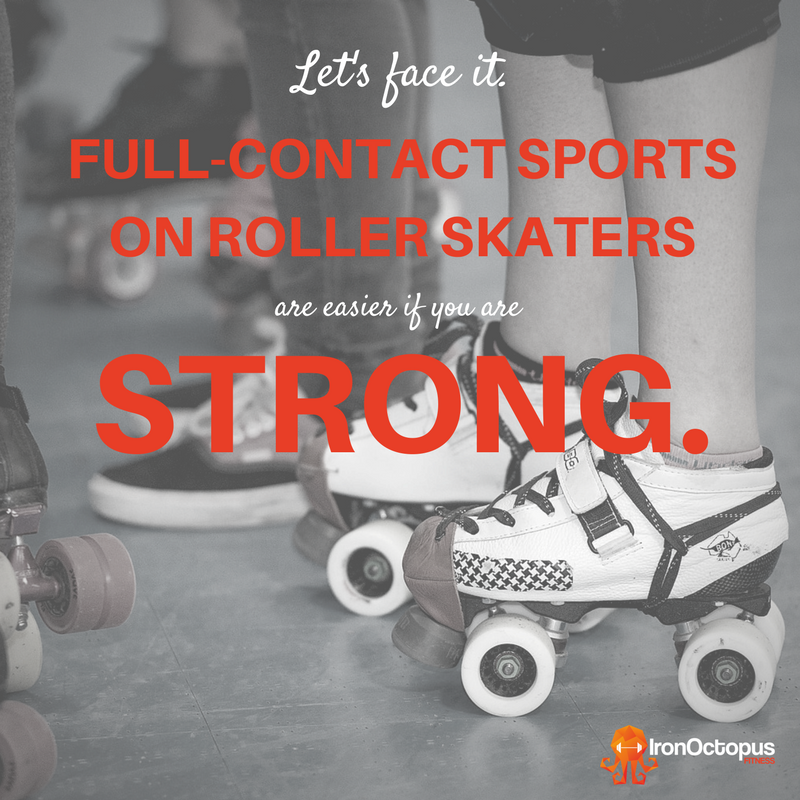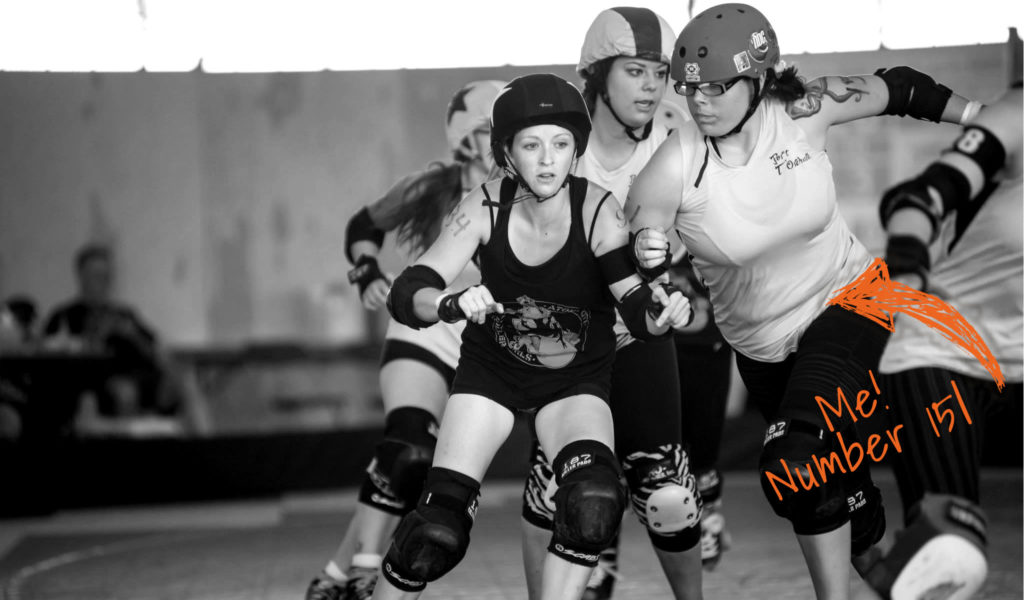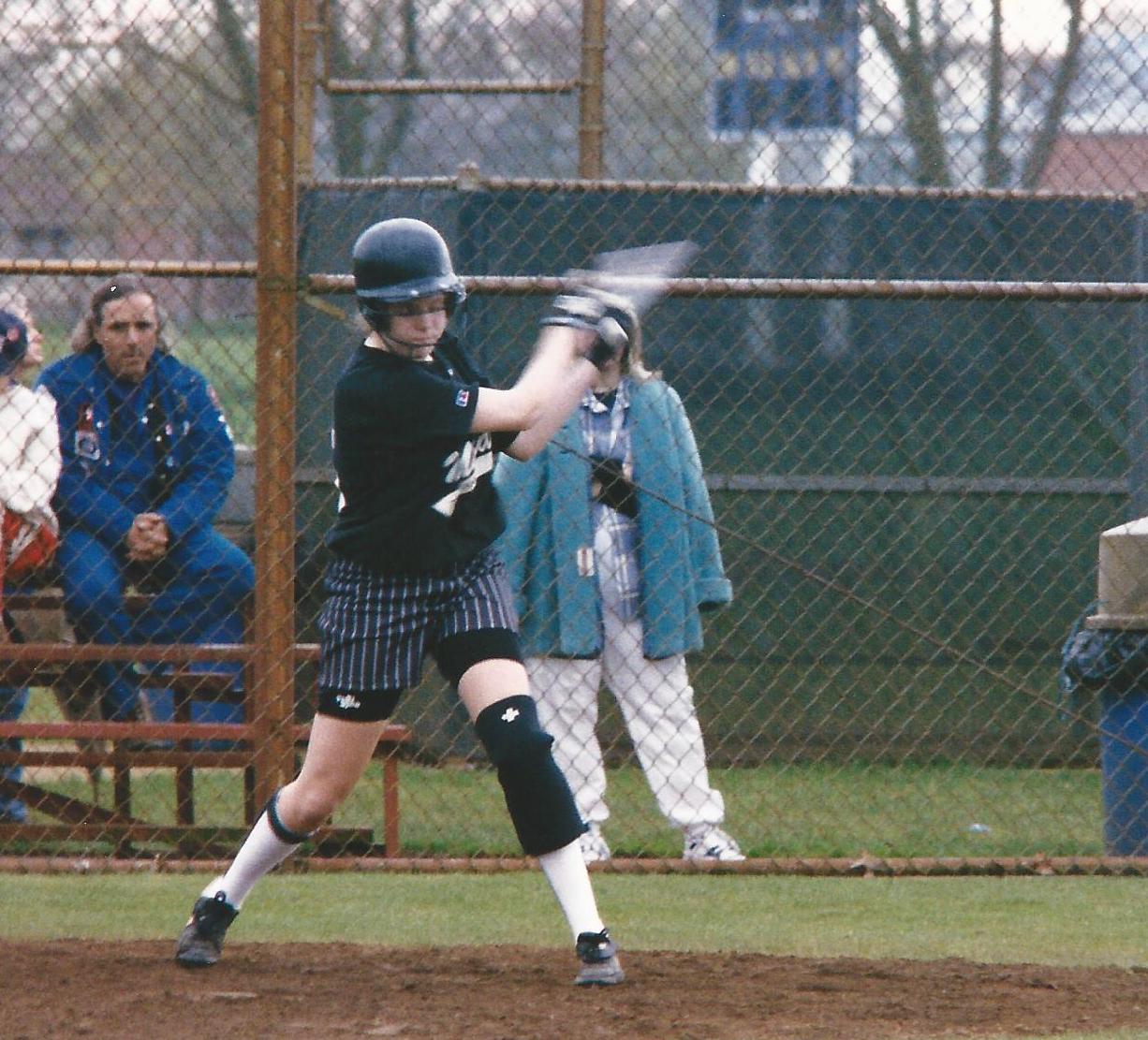
This blog was originally published in December 2017 at Powerlifting University.
THAT APPLY TO EVERYONE.
Imagine a sport where athletic blockers lay gasp-inducing hits on each other.
You can hear the grunts of exertion and the shouts of call signs that foreshadow the use of a specific strategy. Quick-footed players run through walls of the opposing team, sometimes getting stopped cold, sometimes finding a hole to burst through, and sometimes dancing back-and-forth laterally in an elaborate game of chicken.
Now imagine there’s no ball.
And everyone is wearing roller skates.
That’s roller derby.
The sport has grown in recent years outside of the theatrics-wearing-fishnets beginning that most folks picture when they think of modern roller derby. It’s a little bit like American football or rugby, but on skates. With some elements of speed and figure skating thrown in. And everything is fire.
Okay…maybe not that last part.
Suffice it to say that roller derby players — even recreational ones — are definitely athletes. I mean, have you ever seen an average adult on roller skates? Even propelling yourself in a large, gentle circle with no danger of being flattened by another human being isn’t easy.
The first time I landed on my ass at roller derby practice, I wasn’t playing the sport. I wasn’t near another player. I wasn’t even skating. I was standing stock still.
It was jarring, to say the least. I’ve become pretty proficient at standing, unmoving, in a single location over the course of my life. I’ve waited in line at Disneyland for fuck’s sake. So when I toppled ass over teakettle STANDING STILL at my first practice, I occurred to me that if I wanted to make a go of this sport, then I needed to re-assess my approach.
Little did I know that the lessons I learned preparing to hurtle myself through space on skates would change what I could do the rest of the time too.
Turns out, roller derby is a lot like life.
Strength matters.
The primary concern for any new roller derby athlete is trying to figure out how to move with wheels on their feet. It takes up a lot of the mental bandwidth for the first couple of months. At least.
But just like with any new skill, wheeled or not, eventually you become pretty proficient at the basics. You get your skating stride down. You stop gasping for breath after every lap. You’re not struggling as much.
You’re not a beginner anymore.
Spending MORE time on your skates isn’t going to yield any impressive results because you’ve reached the top of your threshold for what your body can do on skates.
ENTER STRENGTH TRAINING.
For a roller derby athlete, it can be the difference between skating the prescribed number of laps in 5 minutes or skating them in 4 ½ minutes. (A pretty large margin in the world of skates.) It can be the difference between hitting that point scorer out to keep them from collecting points or them sneaking by you on the outside line. It’s the difference between absorbing a hit to stay upright and getting launched through the air to land on your ass.
In short, strength matters.
In real life, it’s often touted as the difference between carrying the groceries in one trip versus needing to take two or three. (Or, god forbid, 4 or more.) But building on your own personal foundation of strength — above and beyond what you can manage going about your daily business — is also the difference between being able to pick up your grandkids someday or not being able to do that. It’s the difference between saying yes to a hike with friends because you know you can make it or having to turn the adventure down.
And, if you commute like I used to, it’s sometimes the difference between catching the ferry or missing it.
In roller derby and in life, you can GET BY without building strength. But why would you?
Strength just makes it ALL easier.
1. Embrace Single-Sided Training.
Roller skating is essentially just an elaborate transfer of weight from one leg to the other to keep yourself rolling. On a good day — i.e. one where you aren’t constantly falling on your face — a skater spends upwards of 80% of their time balancing on one foot or the other.
Learning to balance on each leg WHILE DOING OTHER THINGS like yelling or spinning around or body slamming another human is key to being a successful roller derby athlete. Each leg needs to be strong individually if you want to skate (and play) well.
Not only is having all your limbs equally strong important for dynamic skating, it’s pretty damn important in everyday life, too.
Shortly after I started focusing more on single-sided training, as I was trying to corral my little one downstairs, a terrifying thing happened. My son straight up trust fell toward me from the very top of the stairs.
A full-on, no-holds-barred complete surrender to his trust in me (and gravity, of course).
I happened to be carrying a dirty diaper, a full water bottle, and a backpack full of school supplies at the time. I was half-turned away and distracted.
Out of the corner of my eye, I saw the beginning of the trust fall. Whipping around as fast as I could, I managed to halt my son’s fall to the death with a single hand on his stomach. He laughed maniacally as I held him there suspended at a 45° angle above his impending doom.
He could have died, the little jerk.
After recovering from my heart attack and returning those little feet to pitter-patter against solid ground, I realized something: There is NO WAY I would have been able to do that if I didn’t lift weights.
More specifically, if I didn’t challenge each arm and leg individually.
2. Your Butt Is Your Anchor.
Glutes are such a huge part of skating that the “derby booty” is a much-coveted part of the sport. People write odes to it. Big butts, amirite?
Your glutes are one of the largest muscles in your body and hugely important to power your everyday locomotion. Whether you’re in shoes or on skates. Just imagine trying to walk without a butt.
Some of this sought after “derby booty” happens due to sheer repetitive motion, but a lot of it is cultivated on purpose by skate athletes.
Why?
Not only do strong butts look good, but building a strong backside can help alleviate back pain and improve posture. Things that spring up in the general population just as often as they do for those of us that live in skates.
In a roller derby athlete, a lazy ass slows you down. It keeps you slow to react. And there isn’t as much padding to land on.
In everyday life, a lazy ass can lead to lower back aches and an inability to find pants that fit well. Work that butt.
Also, nobody writes songs about small butts.
3. Mix It Up.
Athletes, by virtue of their practice and game schedules, need to mix up their training. Off-season allows for time to massively improve strength or muscle mass. Pre-season requires a hard push into muscular endurance so that you can stay on your skates for a long period. Then onto sports specific training a few times a week with a hard focus on performing in practice. Usually followed by a deload or active recovery week.
Not only does training this way keep roller derby athletes from burning out or getting bored as hell, it also means that the training they are doing matches the goal they have.
You don’t need to mix up your training to confuse your muscles. But mixing it up definitely helps you cultivate and maintain strength. Without getting bored.
As times progresses, goals change. So too should your training.
4. Leg Day Every Day.
I used to have a trainer that would send me messages on my leg days that simply said, “Roast dem wheels.” I hated it. Mostly because it felt like I was training legs every day. That paired with skating definitely lit my lower extremities on fire.
But legs are the engine that drive the car. Especially when you skate every (other) day.
I certainly didn’t hate how much easier skating was. Or how much faster I got. Or how quickly I recovered from game days.
Leg day every day doesn’t mean you have to roast your wheels and stumble out of the gym every time the sun rises, but that giving your leg muscles a little love every day isn’t a bad idea.
Got lazy glutes like the rest of the population? Throwing some focused glute work into every day of your training is not the worst idea ever.
Neither is a 20-minute leisure walk.
Your legs (and stress levels) will thank you.
5. A Jacked Back & A Nice Set of Shoulders.
You know what you don’t really think about when it comes to roller derby? Upper body strength. For a lot of athletes that play this sport, training the upper body takes a back seat. You might as well be a centaur with a gloriously strong lower half and a wet noodle stacked on top.
Contact athletes have to deal with some pretty heavy-hitting to their upper bodies. Particularly their shoulders. OUCH.
Focusing strength training on the back and shoulders can keep your arms from unceremoniously popping out their sockets when someone smashes into you. But it also helps to undo all that shitty posture from hunching over while skating. (Or while…ahem…sitting at your desk or slouching over your phone.)
And a lot of roller derby uniforms are tank tops. Hashtag vanity.
WANT MORE?
If you’re new to lifting and building strength, join BEGINNER STRENGTH SCHOOL.
Beginner Strength School is for you if you’ve been wanting to embark on your strength training journey but didn’t know where to start. If you want a simple program that will introduce to lifting weights and increasing your athleticism, look no further.
- A private coaching group for accountability and support and you get started with lifting.
- 4 strength training workouts that focus on basic moves.
- Coaching videos for EVERY exercise so you can get your form locked in.
- Sample schedules to help you train around practices.
- Quick. Super quick. 30 minutes or less each day.
This is the program I would have gift-wrapped and handed to myself the second I considered putting skates on my feet. And that’s why I’m excited to share it with you!



Thank you for this article! I miss playing derby so bad it physically hurts! I have been using an app for training, but have been pretty bored. Hope this one can be a great supplement!
I hope this alleviates your boredom. Derby will be back sooooon. 👀